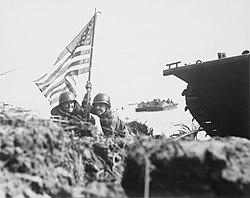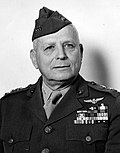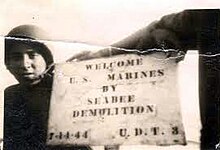Battle of Guam (1944)
This article relies largely or entirely on a single source. (July 2020) |
| Battle of Guam | |||||||
|---|---|---|---|---|---|---|---|
| Part of the Mariana and Palau Islands campaign of the Pacific Theater (World War II) | |||||||
 Marines planting the US flag | |||||||
| |||||||
| Belligerents | |||||||
|
|
| ||||||
| Commanders and leaders | |||||||
| |||||||
| Units involved | |||||||
| 29th Division | ||||||
| Strength | |||||||
| |||||||
| Casualties and losses | |||||||
|
| ||||||
| 600+ civilians killed[3] | |||||||
The Battle of Guam (21 July–10 August 1944) was the American recapture of the Japanese-held island of Guam, a U.S. territory in the Mariana Islands captured by the Japanese from the U.S. in the 1941 First Battle of Guam during the Pacific campaign of World War II. The battle was critical component of Operation Forager. The recapture of Guam and the broader Mariana and Palau Islands campaign resulted in the destruction of much Japan's naval air power at the Battle of the Philippine Sea (on June 19–20, 1944) and allowed the United States to establish large airbases from which it could bomb the Japanese home islands with its new strategic bomber, the Boeing B-29 Superfortress.
Background[]
Guam, at 212 square miles (543 square kilometers), is the largest island of the Marianas, with a length of 32 miles (52 km) and a width ranging from 12 miles (19.31 km) to four miles (6.44 km) at different points of the island.[1][4] It had been a United States possession since its capture from Spain in 1898 until it was captured by the Japanese on 10 December 1941, following the attack on Pearl Harbor. During the Japanese occupation of Guam, it was not as heavily fortified as the other Mariana Islands such as Saipan that had been Japanese possessions since the end of World War I. But by 1944, Guam had a large Japanese garrison.
The Allied plan for the invasion of the Marianas, Operation Forager, called for heavy preliminary bombardment, first by carrier aircraft and USAAF bombers based in the Marshall Islands to the east, then once air superiority was gained, close bombardment by battleships, cruisers, and destroyers.[1]: 22 Saipan, Tinian, and Guam were chosen as the targets due to their size and suitability as a base for supporting the next stage of operations toward the Philippines, Taiwan, and the Ryukyu Islands. The seaport at Apra Harbor was suitable for the largest ships; and air bases for Boeing B-29 Superfortresses could be built from which to bomb Japan. B-24 Liberators from the Marianas could also bomb Iwo Jima and the Bonin Islands, such as Chichi Jima.[1]: 22
The invasion of Saipan was scheduled for 15 June 1944, with landings on Guam tentatively set for 18 June.[1]: 22 The original timetable was optimistic, however. A large Japanese carrier attack and stubborn resistance by the unexpectedly large Japanese garrison on Saipan led to the invasion of Guam being postponed for a month.[1]: 25
U.S. naval and air bombardments lasted from 11 to 13 June 1944, involving 216 carrier aircraft and land-based B-24 bombers from the Marshall Islands. On 12 and 13 June, 12 Japanese cargo ships and several fishing vessels were sunk. On 27 June, U.S. Navy battleships and cruisers started shelling the island, joined by a U.S. carrier group on 4 July, and two more on 6 July.[1]: 42
Opposing forces[]
commanders on Guam





![]() United States
United States
US Fifth Fleet
Admiral Raymond A. Spruance, USN
Southern Attack Force (Task Force 53)
Vice Admiral Richard L. Conolly, USN
Expeditionary Troops
Lieutenant General Holland M. Smith, USMC
Approx. 48,200 officers and enlisted
III Marine Amphibious Corps
Major General Roy S. Geiger, USMC
- Northern landing area:
3rd Marine Division
- Maj. Gen. Allen H. Turnage, USMC
- Southern landing area:
 1st Provisional Marine Brigade
1st Provisional Marine Brigade
- Brig. Gen. Lemuel C. Shepherd Jr., USMC
- Reserve:
 77th Infantry ("Statue of Liberty") Division
77th Infantry ("Statue of Liberty") Division
- Maj. Gen. Andrew D. Bruce, USA


![]() Japan
Japan
Defenses of Guam
Lieutenant General Takeshi Takashina (KIA 28 July)
Thirty-First Army
Lieutenant General Hideyoshi Obata (seppuku 11 August)
Approx. 19,000 officers and enlisted
- 29th Division (Lt. Gen. Takashina)
- 1st Tank Division
- 48th Independent Brigade
- 10th Independent Mixed Regiment
Battle[]




Before landing, US forces sought to ensure both air and naval superiority. A total of 274 ships, which fired 44,978 shots from 2-inch and 5-inch guns supported the landing. In addition, a total of 13 aircraft carriers participated in the air raid and a total of 4,283 bombs (weighing a total of 1,310 tons) were dropped from 18 to 20 July, the day before disembarkation. The heavy bombardment burned all the palm trees on the beach and destroyed every building that could be seen. Experience gained by the Japanese from the invasion of Saipan was used to try to mitigate the effects of the bombardment. Despite this, the bombardment far exceeded the expectations of the defending forces which were dug in along the coast as they were on Saipan. Many of the bases and guard towers were also destroyed. However, artillery pieces entrenched in dense forests, caves, trenches and locations four kilometers or more from the coast were able to escape destruction and became a source of heavy Japanese resistance. Guam, ringed by reefs, cliffs, and heavy surf, presents a formidable challenge for any attacker.[1]: 14 Underwater demolition teams reconnoitered the beaches and removed obstacles from 14 to 17 July.[1]: 43 Despite the obstacles, on 21 July, the American forces landed on both sides of the Orote Peninsula on the western side of Guam, planning to secure Apra Harbor.[1]: 23 The 3rd Marine Division landed near Agana to the north of Orote at 08:29, and the 1st Provisional Marine Brigade landed near Agat to the south.[1]: 24, 44 Japanese artillery sank 30 U.S. LVTs and inflicted heavy casualties on the landing troops, especially of the 1st Provisional Marine Brigade, but by 09:00 marines and tanks were ashore at both beaches.
By nightfall, the U.S. Marines and soldiers of the 77th Infantry Division had established beachheads about 6,600 feet (2,000 m) deep.[5] Japanese counterattacks were made throughout the first few days of the battle, mostly at night, using infiltration tactics. The Japanese penetrated the American defenses several times but were driven back with heavy losses of men and equipment.
The U.S. Army's 77th Infantry Division had a more difficult landing on 23–24 July.[1]: 17 Lacking amphibious vehicles, they had to wade ashore from the edge of the reef where the landing craft dropped them off. The men stationed in the two beachheads were pinned down by heavy Japanese fire, making initial progress inland quite slow. Supply was very difficult[6] for the landing troops on Guam in the first days of the battle. Landing ships could not come closer than the reef, several hundred yards from the beach, and amphibious vehicles were scarce.
The 1st Provisional Brigade blocked off the Orote Peninsula on 25 July, and that same night Japanese Lt. General Takashina counterattacked, coordinated with a similar attack against the 3rd Division to the north.[1]: 56 The next day, General Obata reported, "our forces failed to achieve the desired objectives."[1]: 61 Lieutenant General Takeshi Takashina was killed on 28 July, and Lieutenant General Hideyoshi Obata took over the command of the Japanese defenders.[1]: 65 On 28 July, the two beachheads were linked,[1]: 17 and by 29 July, the Americans secured the peninsula.[1]: 64
The Japanese counterattacks against the American beachheads, as well as the fierce fighting, had exhausted the Japanese. At the start of August, they were running out of food and ammunition, and they had only a handful of tanks left. Obata withdrew his troops from southern Guam, planning to make a stand in the mountainous central and northern part of the island, "to engage in delaying action in the jungle in northern Guam to hold the island as long as possible".[1]: 65
After ensuring that no significant Japanese forces operated in the southern portion of Guam, Marine Major General Geiger started an offensive north with the 3rd Marine Division on the left flank, and the 77th Infantry Division on the right, liberating Agana on the same day.[1]: 70 The Tiyan Airfield was captured on 1 Aug.[1]: 72
Rain and thick jungle made conditions difficult for the Americans, but after an engagement with the main Japanese line of defense around Mount Barrigada from 2–4 August, the Japanese line collapsed.[1]: 73–74 The 1st Provisional Brigade formed up on the left flank of the 3rd Marine Division on 7 August because of the widening front and continued casualties, in an effort to prevent the Japanese from slipping through the American gaps.[1]: 75–76 The Japanese had another stronghold at Mount Santa Rosa, which was secured on 8 August.[1]: 74, 81
On 10 August, organized Japanese resistance ended, and Guam was declared secure, but 7,500 Japanese soldiers were estimated to be at large.[1]: 81 The next day, Obata committed ritual suicide at his headquarters on Mount Mataguac after he had sent a farewell message to Japan.[1]: 81
Aftermath[]


A few Japanese soldiers held out in the jungle after the fighting on Guam.[1]: 87 On 8 December 1945, three U.S. Marines were ambushed and killed. Sergeant Masashi Itō surrendered on 23 May 1960, after the last of his companions was captured. On 24 January 1972, Sergeant Shoichi Yokoi was discovered by hunters on the island. He had lived alone in a cave for 28 years, near Talofofo Falls.
Guam was turned into a base for Allied operations after the battle. 5 large airfields were built by the Navy Seabees and African American Aviation Engineering Battalions. Army Air Forces B-29 bombers flew from Northwest Field and North Field on Guam to attack targets in the Western Pacific and on mainland Japan.[1]: 87–88
Guam's native Chamorro population had suffered considerably during Japanese occupation, and the Japanese soldiers began to commit atrocities during the preparation for the invasion. In what became known as the Maneggon March, the Japanese soldiers forced most of the island's population to march into six concentration camps in southern Guam. The sick and starving were left for dead along the way, and Japanese troops massacred about 600 civilians out of Guam's population of roughly 20,000. As many as 2,000 may have been killed during the occupation. Liberation Day continues to be celebrated on Guam every 21 July.[3]
Unit awards[]
- 1st Provisional Marine Brigade, 21 July to 10 August 1944
Medal of Honor recipients[]
Four Medal of Honor recipients of the Battle of Guam:
- Captain (later General) Louis H. Wilson, Jr., USMC
- Private First Class Leonard F. Mason, USMC (posthumous)
- Private First Class (later Corporal) Luther Skaggs Jr., USMC
- Private First Class Frank Witek, USMC (posthumous)
See also[]
- 18th Infantry Regiment (Imperial Japanese Army)
- Agana race riot – Violent confrontation between white U.S. Marines and black U.S. sailors
- Battle of Guam (1941)
- Pacific War Museum
- Return to Guam, 1944 documentary and propaganda film about the battle
- The War in the Pacific National Historical Park
- George Ray Tweed
- Nimitz Hill
References[]
- ^ a b c d e f g h i j k l m n o p q r s t u v w x y z aa ab ac ad Rottman, Gordon L (2004). Guam 1941 & 1944: Loss and Reconquest (1st ed.). Botley: Osprey Publishing Ltd. ISBN 978-1-84176-811-3. Retrieved 1 November 2020.
- ^ Taki, The history of battles of Imperial Japanese Tanks[incomplete short citation]
- ^ a b Gruhl, Werner (2007). Imperial Japan's World War Two: 1931-1945 (1st ed.). Transaction Publishers. ISBN 978-0-7658-0352-8. Retrieved 15 November 2020.
- ^ "Guam's Geography at ns.gov.gu". ns.gov.gu. Retrieved 2 May 2016.
- ^ Gailey (1988), pp.90–112.
- ^ Video: Allies Study Post-War Security Etc. (1944). Universal Newsreel. 1944. Retrieved 21 February 2012.
Further reading[]
- Anderson, Charles R. Western Pacific. U.S. Army Campaigns of World War II. United States Army Center of Military History. CMH Pub 72-29.
- Gailey, Harry (1988). The Liberation of Guam 21 July – 10 August. Novato, California, U.S.A.: Presidio Press. ISBN 978-0-89141-651-7.
- Guam: Operations of the 77th Division. American Forces in Action series. United States Army Center of Military History. 1990 [1946]. CMH Pub 100-5.
- Hatashin, Omi (2009). Private Yokoi's War and Life on Guam, 1944–72: The Story of the Japanese Imperial Army's Longest WWII Survivor in the Field and Later Life. Honolulu: University of Hawaii Press. ISBN 978-1-905246-69-4.
- Manchester, W., 1980, Goodbye, Darkness: A Memoir of the Pacific War, Boston: Little, Brown, and Co., ISBN 978-0-316-54501-3, pp 278–302
External links[]
| Wikimedia Commons has media related to Battle of Guam. |
- Battle for the Mariana Islands on YouTube
- "The Marianas and the Great Turkey Shoot", World War II Database.
- Lodge, Major O.R. USMC Historical Monograph: The Recapture of Guam, Historical Branch, United States Marine Corps, 1954.
- O'Brien, Cyril J. Liberation: Marines in the Recapture of Guam, Marines in World War II Commemorative Series, Marine Corps Historical Center, United States Marine Corps, 1994.
- Dyer, George Carroll (1956). "The Amphibians Came to Conquer: The Story of Admiral Richmond Kelly Turner". United States Government Printing Office. Archived from the original on 21 May 2011. Retrieved 5 May 2011.
- Keene, R.R. "Wake up and die, Marine!". Leatherneck Magazine.
- Photos from the Liberation of Guam The Real Revo
- A film clip Allies' Study: Post-War Security, etc. (1944) is available at the Internet Archive
- Pacific War Museum National Park Service site
Coordinates: 13°22′09″N 144°39′03″E / 13.3693°N 144.6509°E
- Conflicts in 1944
- Pacific Ocean theatre of World War II
- History of Guam
- 1944 in Guam
- World War II operations and battles of the Pacific theatre
- Battles of World War II involving Japan
- Battles of World War II involving the United States
- United States Marine Corps in World War II
- Amphibious operations of World War II
- July 1944 events
- August 1944 events
- Amphibious operations involving the United States
- Military in Guam
